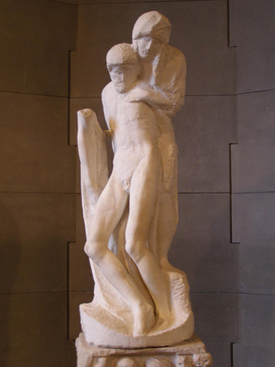 This year’s trip to Italy, as part of the core course The Florentine Renaissance and its Values, offered an additional excursion to ECLA Academy Year and BA First Year students: a day in Milan.In the course’s history, where students spend several days in Florence at the beginning of the spring term, brief visits to other cities, including Rome, Milan and Siena, have been part of the curriculum.
This year’s trip to Italy, as part of the core course The Florentine Renaissance and its Values, offered an additional excursion to ECLA Academy Year and BA First Year students: a day in Milan.In the course’s history, where students spend several days in Florence at the beginning of the spring term, brief visits to other cities, including Rome, Milan and Siena, have been part of the curriculum.
A visit to Milan allowed students to see a number of works by Leonardo da Vinci, most prominently The Last Supper at Santa Maria delle Grazie. Viewing the work in person permitted us to note details that are difficult to perceive from a copied image, such as the feet of the disciples.
The painting has gone through many restorations due to Leonardo’s use of gesso and mastic on a stone wall rather than tempura because the latter dries too quickly and restricts alterations. The difference between painting techniques is immediately noticeable when one looks at the well preserved fresco of a crucifixion by Giovanni Donato on the wall opposite The Last Supper.
Another artistic work students visited and studied was the Milan Cathedral in the historic center of the city. The immense structure has a highly gothic inside and an eclectic façade that reminded us of the several different centuries dedicated to the building’s construction.
Our visit to this Cathedral was a return to the gothic after concentrating on the renaissance churches of Brunelleschi in Florence such as San Lorenzo and Santo Spirito. Another church of Milan visited was Santa Maria presso San Satiro, a small cathedral that most interestingly features a mural from Bramante that stands in as a choir through the device of trompe-l’oeil. Bramante plays with the concept of perspective initiated by artists like Brunelleschi to give the illusion that the wall of the cathedral goes further into space than it actually does.
The peak of our experiences in Milan may have been a visit to the Sforza Castle. The castle that served as the residence for the Sforza dynasty, now houses a major museum. Part of the original internal decoration of the castle is a ceiling painted by da Vinci.
We carefully discussed his abstract design in the room given the name Sala delle asse, or ‘chamber of wooden boards’, depicting the innumerable entangling of vegetation alongside ropes and knots. Some form of beauty is offered through this piece’s immeasurable complication of a simple subject matter.
Also in the museum is the last pietà, and purportedly the last sculpture, of Michelangelo. The unfinished piece (referred to as Rondanini Pietà) was intermittently worked on by the artist for about a decade. It shows the Virgin Mary supporting the corpse of Christ from behind. The faces of both figures are wholly indistinct. As opposed to Michelangelo’s traditional monumental style, this sculpture depicts the human body as long and thin, with a high head to body ratio.
One of the greatest pleasures of students encountering this sculpture was the comparative analysis we were able to make through another late pietà by Michelangelo when we visited, The Deposition in Museo dell’Opera del Duomo of Florence.
Students were amazed by this more complete, but arguably still unfinished, sculpture. It displays four figures, the Virgin Mary, Christ, Mary Magdalene, and an ambiguous male that overlooks and possibly supports the other three characters. The face of this figure is widely considered to be a self-portrait of Michelangelo.
Most noteworthy is how the artist potently portrays the collapsed muscles of Christ. One’s conception of the sculpture’s development is heightened when comparing this feature to the Rondanini Pietà, where the body of Christ has no definition.
There are a couple of similarities, however, between these two sculptures. The first is that in both the heads of Christ and his mother Mary are merged. In the Florentine pièta Jesus’ head is adjoined to the right side of Mary’s face, and with the Milan pietà he joins the right side of her chin.
Both pieces also suggest an internal conflict and artistic misgivings on the part of Michelangelo. Both sculptures depict a space where part of the sculpture was literally chopped off. The Deposition portrays Jesus with only one leg; the other, draping over the lap of the Virgin, was removed.
Rondanini contains the bottom half of a well defined arm that is attached to no body. This arm is supposed to have belong to Christ but due to the chest of Christ being overworked, the arm could no longer be proportionate to the body. Michelangelo therefore chose to chop off the arm and shoulder of Christ.
Therefore these two pieces that were expected to decorate the burial place of Michelangelo display both the artist’s ability to depict the beautiful and his own struggles with his artistic endeavour.
Michael David Harris (AY’12, USA)
